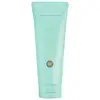What's inside
What's inside
 Key Ingredients
Key Ingredients

 Benefits
Benefits

 Concerns
Concerns

 Ingredients Side-by-side
Ingredients Side-by-side

Water
Skin ConditioningGlycerin
HumectantPropylene Glycol
HumectantCoco-Glucoside
CleansingAmmonium Polyacryloyldimethyl Taurate
Emulsion StabilisingGlycolic Acid
BufferingSodium Methyl Cocoyl Taurate
CleansingNiacinamide
SmoothingLactic Acid
BufferingSodium Hydroxide
BufferingCarica Papaya Fruit Extract
Skin ConditioningIlex Paraguariensis Leaf Extract
PerfumingPassiflora Edulis Fruit Juice
Skin ConditioningZingiber Officinale Root Extract
MaskingAscorbyl Glucoside
AntioxidantCaffeine
Skin ConditioningCapryloyl Salicylic Acid
ExfoliatingPhytic Acid
Tocopherol
AntioxidantBisabolol
MaskingCaprylyl Glycol
EmollientCitric Acid
BufferingCoconut Acid
CleansingEthylhexylglycerin
Skin ConditioningHelianthus Annuus Seed Oil
EmollientSodium Chloride
MaskingTrideceth-9
EmulsifyingLimonene
PerfumingLinalool
PerfumingCI 40800
Cosmetic ColorantChlorphenesin
AntimicrobialPhenoxyethanol
PreservativePotassium Sorbate
PreservativeSalicylic Acid
MaskingSodium Benzoate
MaskingParfum
MaskingWater, Glycerin, Propylene Glycol, Coco-Glucoside, Ammonium Polyacryloyldimethyl Taurate, Glycolic Acid, Sodium Methyl Cocoyl Taurate, Niacinamide, Lactic Acid, Sodium Hydroxide, Carica Papaya Fruit Extract, Ilex Paraguariensis Leaf Extract, Passiflora Edulis Fruit Juice, Zingiber Officinale Root Extract, Ascorbyl Glucoside, Caffeine, Capryloyl Salicylic Acid, Phytic Acid, Tocopherol, Bisabolol, Caprylyl Glycol, Citric Acid, Coconut Acid, Ethylhexylglycerin, Helianthus Annuus Seed Oil, Sodium Chloride, Trideceth-9, Limonene, Linalool, CI 40800, Chlorphenesin, Phenoxyethanol, Potassium Sorbate, Salicylic Acid, Sodium Benzoate, Parfum
Water
Skin ConditioningGlycerin
HumectantSodium Lauroyl Aspartate
CleansingPEG-150 Pentaerythrityl Tetrastearate
EmulsifyingLauryl Glucoside
CleansingSodium Lauryl Glycol Carboxylate
CleansingSaccharomyces/Rice Ferment Filtrate
Skin ConditioningCamellia Sinensis Leaf Extract
AntimicrobialCladosiphon Okamuranus Extract
Skin ConditioningSalix Alba Bark Extract
AstringentArtemisia Princeps Leaf Extract
Skin ConditioningCoix Lacryma-Jobi Ma-Yuen Seed Extract
Skin ConditioningCocamidopropyl Betaine
CleansingSodium Carbonate
BufferingButylene Glycol
HumectantPropanediol
SolventEthylhexylglycerin
Skin ConditioningAlcohol
AntimicrobialCitric Acid
BufferingPhenoxyethanol
PreservativeChlorphenesin
AntimicrobialCI 19140
Cosmetic ColorantCI 42090
Cosmetic ColorantWater, Glycerin, Sodium Lauroyl Aspartate, PEG-150 Pentaerythrityl Tetrastearate, Lauryl Glucoside, Sodium Lauryl Glycol Carboxylate, Saccharomyces/Rice Ferment Filtrate, Camellia Sinensis Leaf Extract, Cladosiphon Okamuranus Extract, Salix Alba Bark Extract, Artemisia Princeps Leaf Extract, Coix Lacryma-Jobi Ma-Yuen Seed Extract, Cocamidopropyl Betaine, Sodium Carbonate, Butylene Glycol, Propanediol, Ethylhexylglycerin, Alcohol, Citric Acid, Phenoxyethanol, Chlorphenesin, CI 19140, CI 42090
 Reviews
Reviews

Ingredients Explained
These ingredients are found in both products.
Ingredients higher up in an ingredient list are typically present in a larger amount.
Chlorphenesin is a synthetic preservative. It helps protect a product against bacteria in order to extend shelf life. In most cases, Chlorphenesin is paired with other preservatives such as phenoxyethanol and caprylyl glycol.
Chlorphenesin is a biocide. This means it is able to help fight the microorganisms on our skin. It is also able to fight odor-releasing bacteria.
Chlorphenesin is soluble in both water and glycerin.
Studies show Chlorphenesin is easily absorbed by our skin. You should speak with a skincare professional if you have concerns about using Chlorphenesin.
Learn more about ChlorphenesinCitric Acid is an alpha hydroxy acid (AHA) naturally found in citrus fruits like oranges, lemons, and limes.
Like other AHAs, citric acid can exfoliate skin by breaking down the bonds that hold dead skin cells together. This helps reveal smoother and brighter skin underneath.
However, this exfoliating effect only happens at high concentrations (20%) which can be hard to find in cosmetic products.
Due to this, citric acid is usually included in small amounts as a pH adjuster. This helps keep products slightly more acidic and compatible with skin's natural pH.
In skincare formulas, citric acid can:
While it can provide some skin benefits, research shows lactic acid and glycolic acid are generally more effective and less irritating exfoliants.
Most citric acid used in skincare today is made by fermenting sugars (usually from molasses). This synthetic version is identical to the natural citrus form but easier to stabilize and use in formulations.
Read more about some other popular AHA's here:
Learn more about Citric AcidEthylhexylglycerin (we can't pronounce this either) is commonly used as a preservative and skin softener. It is derived from glyceryl.
You might see Ethylhexylglycerin often paired with other preservatives such as phenoxyethanol. Ethylhexylglycerin has been found to increase the effectiveness of these other preservatives.
Glycerin is already naturally found in your skin. It helps moisturize and protect your skin.
A study from 2016 found glycerin to be more effective as a humectant than AHAs and hyaluronic acid.
As a humectant, it helps the skin stay hydrated by pulling moisture to your skin. The low molecular weight of glycerin allows it to pull moisture into the deeper layers of your skin.
Hydrated skin improves your skin barrier; Your skin barrier helps protect against irritants and bacteria.
Glycerin has also been found to have antimicrobial and antiviral properties. Due to these properties, glycerin is often used in wound and burn treatments.
In cosmetics, glycerin is usually derived from plants such as soybean or palm. However, it can also be sourced from animals, such as tallow or animal fat.
This ingredient is organic, colorless, odorless, and non-toxic.
Glycerin is the name for this ingredient in American English. British English uses Glycerol/Glycerine.
Learn more about GlycerinPhenoxyethanol is a preservative that has germicide, antimicrobial, and aromatic properties. Studies show that phenoxyethanol can prevent microbial growth. By itself, it has a scent that is similar to that of a rose.
It's often used in formulations along with Caprylyl Glycol to preserve the shelf life of products.
Water. It's the most common cosmetic ingredient of all. You'll usually see it at the top of ingredient lists, meaning that it makes up the largest part of the product.
So why is it so popular? Water most often acts as a solvent - this means that it helps dissolve other ingredients into the formulation.
You'll also recognize water as that liquid we all need to stay alive. If you see this, drink a glass of water. Stay hydrated!
Learn more about Water